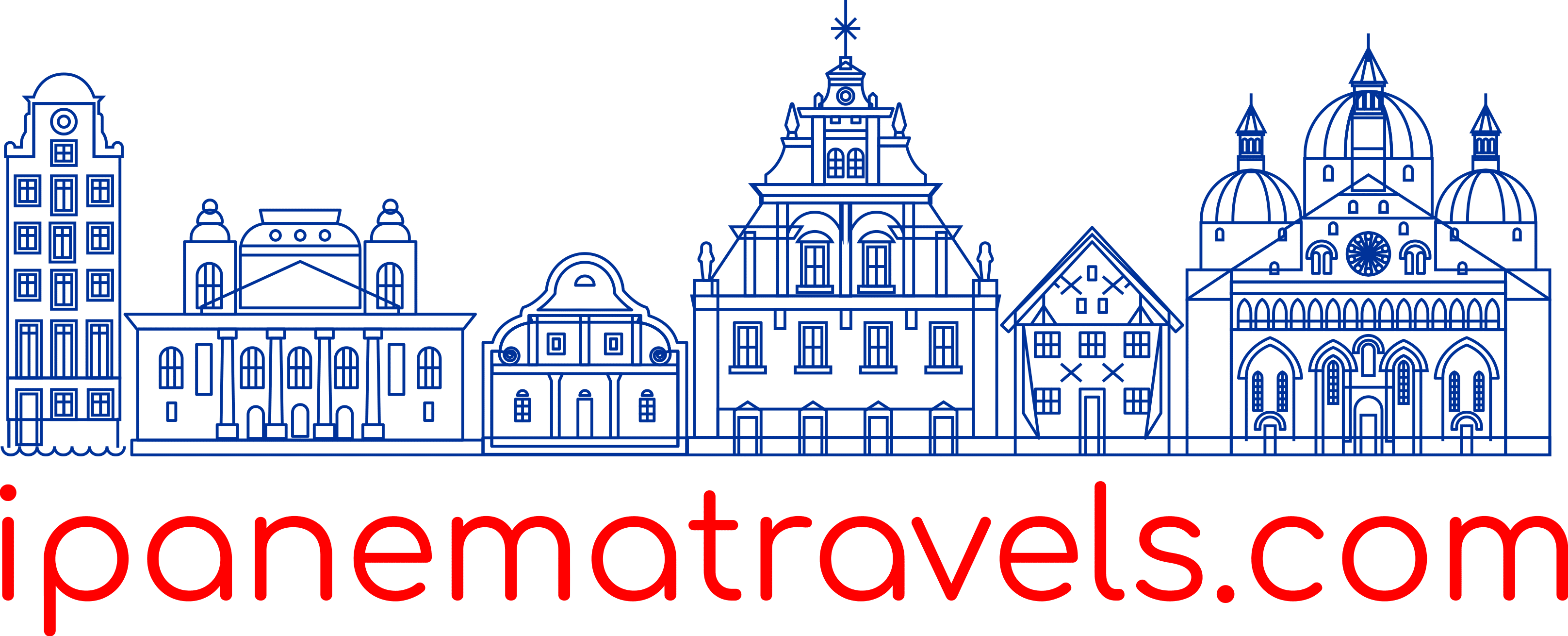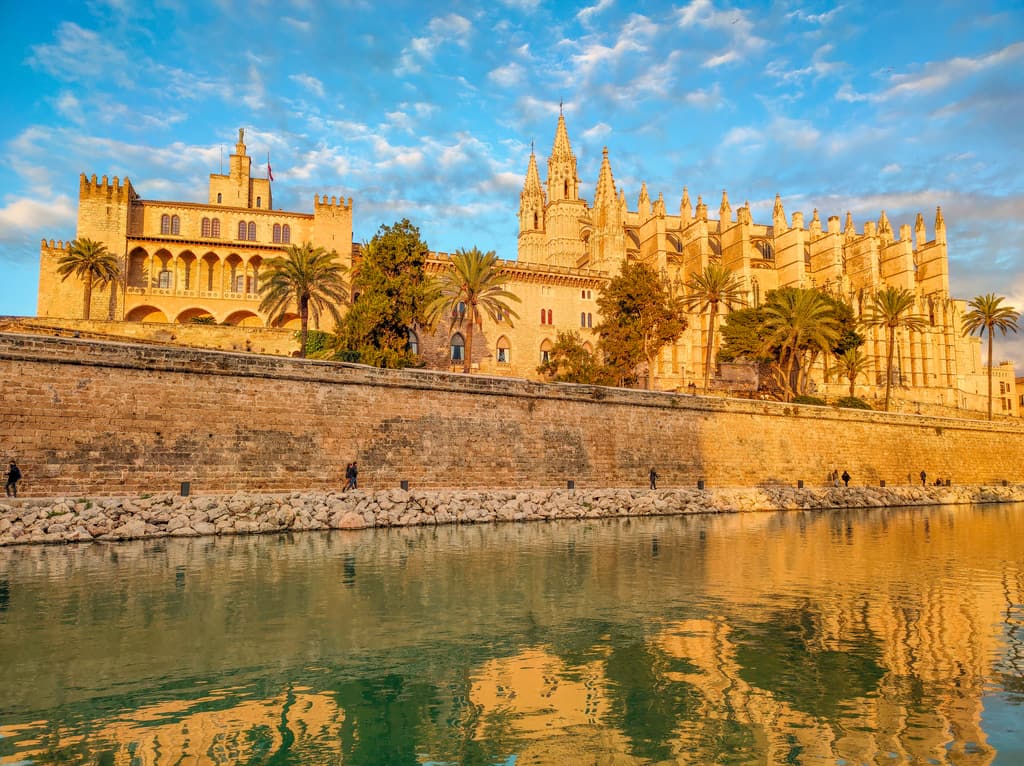Palma is one of those places that you will immediately fall in love with. Medieval architecture, lovely squares, beautiful views, hidden gardens and lots of great food and wine – Palma does not disappoint. Read further to find out what to see and do in Palma with this complete guide of the best things to do in Palma de Mallorca (Spain).
I’ve been thinking about visiting Palma for a long time now, but I had that image of sandy beaches, drunken tourists, overcrowded streets and overbuilt coastline, which wasn’t that attractive at all. However, I decided to give it a try when I heard that the Traverse20 conference would be held there in November 2020. The conference was postponed with a year and I finally arrived in Palma at the end of November 2021.
Palma was nothing like I had imagined. There wasn’t a sign of overtourism besides the gigantic hotels along the coastline. Palma belonged again to its citizens. I don’t know whether it was due to the pandemic and the decreased tourist flow, or to the fact that I was visiting Palma off season, in November. Palma was vibrant, fun and amazing to explore!
Tip: If you are staying in Palma for a couple of days, visit one of the many lovely places on the island on a day trip.
Contents
- How to get to Palma de Mallorca
- Getting around in Palma de Mallorca
- Best things to do in Palma de Mallorca
- 1. Marvel the Cathedral of Mallorca
- 2. Combine Contemporary Art with amazing views at Es Baluard Museum
- 3. Get to know the artist at the Fundació Miró Mallorca Museum
- 4. Enjoy Contemporary Art at the Fundación Juan March for free
- 5. Learn about Palma’s Moorish past at the Banys Àrabs
- 6. Venture outside of the city centre and visit Santa Catalina & El Jonquet neighbourhoods
- 7. Stroll along the seaside
- 8. Stroll along the famous boulevards La Rambla and Passeig des Born
- 9. Taste Palma at one of the local bakeries
- 10. Go on a tapas and wine tour
- 11. Spot Art-Nouveau architecture
- 12. Visit the Royal Palace of La Almudaina
- 13. Take a journey in time at Can Balaguer
- 14. Marvel the beautiful La Llotja
- 15. Visit the round castle Bellver
- 16. Learn about Mallorca at the local museum
- 17. Relax at one of Palma’s beautiful gardens
- 18. Stand in awe of the old olive tree
- 19. Admire the undersea world at Palma Aquarium
DISCLOSURE: This post contains affiliate links. If you make a purchase via one of those links, I will earn a commission at no extra cost for you.
I have visited Palma for the Traverse21 Conference. From all things to do in Palma, as listed below, the visit to the Es Baluard Museum was provided by the City Tourist Board – Visit Palma. I have also received free tokens to use during the TaPalma Festival. The rest of the attractions I have visited on my own. All opinions are mine.
How to get to Palma de Mallorca
Palma de Mallorca (also sometimes written only as Palma or Palma de Majorca) is the capital of the autonomous community of the Balearic Islands, and the largest city on the island of Mallorca (Majorca). Palma shouldn’t be confused with La Palma, which is an island of the Canary Islands and Las Palmas, which is the capital of Gran Canaria. Differentiating between these three can save you some headache when you are booking your flight, or searching for hotels.
Palma’s international airport (PMI) is just a few kilometers outside the city and there is convenient public transport from and to the airport. When I arrived in Palma I used the bus to get to the city centre and a taxi when I was leaving. Both ways, the airport is super easily accessible.
There are direct flights to Palma from some European countries, but the best way to reach the island is via Barcelona on the mainland. There are also frequent flights from other Spanish cities. The flight between Barcelona and Palma is just under an hour. When i was flying via Barcelona I had a connection only of an hour and a half and it was more than enough. I didn’t need to hassle to get my connecting flight.
Getting around in Palma de Mallorca
If you are visiting Palma on a city trip, you won’t need a car. The city centre and the Old Town are best to be explored on foot, besides parking can be a nightmare. If you want to visit places just outside of the city centre, like the Fundació Miró Mallorca or the Palma Aquarium, you can take the bus. The public transport in Palma is really good and quite affordable. In 2021 a one-way ticket costs only 3 EUR. I took myself the bus on a few occasions and in the evening when going out, I used taxis, which are affordable, as well.
When I visited Palma, I didn’t know that you can pay in the buses with your debit/credit card if you have contactless payments enabled. According to the website of the local public transport service provider, you can use your bank card and then you pay only 1,80 EUR. However I haven’t tried this, so I can’t tell you whether it works.

Best things to do in Palma de Mallorca
What to do in Palma? Which places to visit in Palma de Mallorca? What are Palma’s best attractions and Palma’s must-see? I have put together this list of the Palma’s top attractions hoping to help you plan your Palma itinerary when visiting Mallorca’s capital. I had a great time in Palma, visiting off season, which I highly recommend, as you won’t be contributing to the summer crowds. That’s why I haven’t included going to the beach, and other summer activities in Palma.

1. Marvel the Cathedral of Mallorca
The Cathedral of Mallorca in Palma (or La Seu in short) is perhaps the most famous attraction in the city. It’s an absolutely gorgeous building standing atop a hill and overlooking the Mediterranean Sea. The construction of the cathedral started in the 13th century but the building wasn’t finished until 1630.
Tip: For the best views of the cathedral, walk along the Passeig Marítim de Palma at sunset. You will be mesmerized!

Through the years the Cathedral underwent many renovations. At the beginning of the 20th century the famous Modernista architecture Gaudí changed quite a lot the interior of the cathedral. Today, we can see the beautiful canopy above the alter symbolizing the crown of thorns. At the beginning of the 21st century Miquel Barceló created a stunning mural of painted ceramics in the Chapel of the Holy Sacrament (La capella del Santíssim). It represents the miracle of the five loaves and two fish according to the Gospel of Saint John.
Practical info:
Address: Plaza de la Almonia, 07001 Palma
Admission fee: 8 EUR
Opening times for tourists: daily from 10 am to 2:15 pm
Website: www.catedraldemallorca.org
Buy tickets here
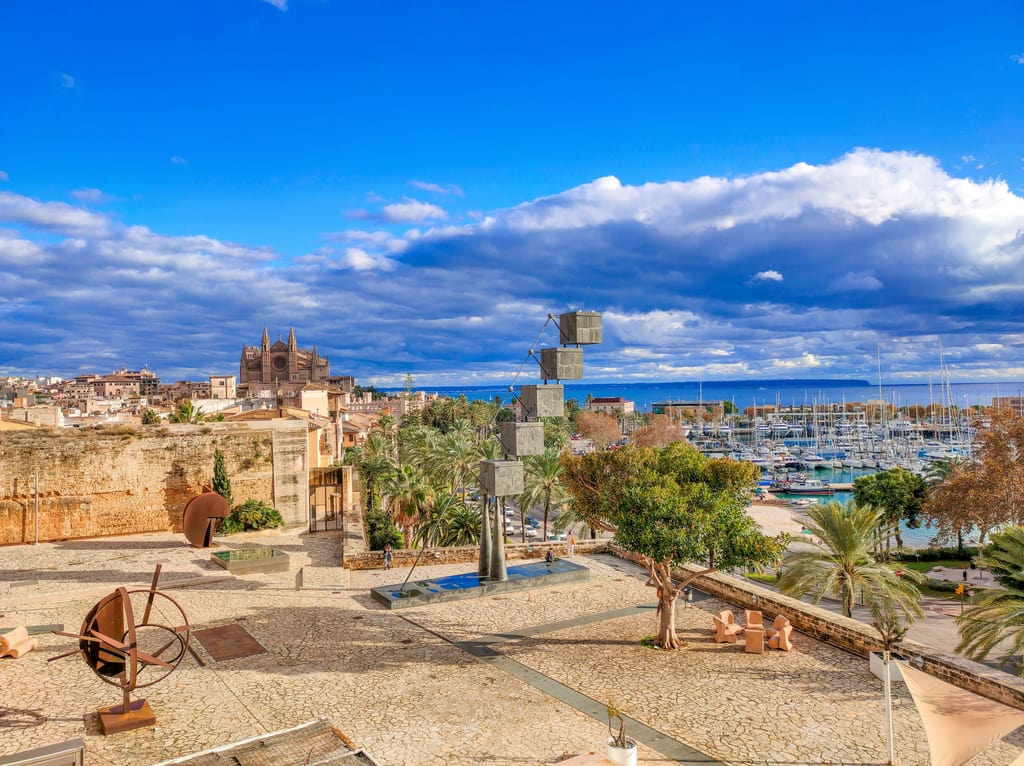
2. Combine Contemporary Art with amazing views at Es Baluard Museum
Es Baluard Museum will treat you not only to great contemporary art, but also to some amazing views of Palma and its famous landmarks. The museum is housed in the 16th-century bastion of Sant Pere (Saint Peter), which once was part of the defensive walls of the city.

The museum opened its doors in 2004 and besides works of Miró, and Picasso, you can see there also works of local Mallorcan artists, like Joaquim Mir, Santiago Rusiñol, Hermen Anglada-Camarasa, Joaquín Sorolla, and Antoni Gelabert. The museum hosts also temporary exhibitions and installations of international artists.
Practical info:
Address: Plaza Porta de Santa Catalina 10, 07012 Palma
Admission fee: adults: 6 EUR, 65+: 4 EUR, kids under 12: free; temporary exhibitions: 4 EUR
Opening times: Tuesday – Saturday from 10 am to 8 pm; Sunday from 10 am to 3 pm; closed on Mondays
Website: www.esbaluard.org

3. Get to know the artist at the Fundació Miró Mallorca Museum
I couldn’t visit Palma without paying tribute to one of the greatest artists of the 20th century – Joan Miró. In 1956 Miró moved to Mallorca, as both his mother and his wife Pilar were born there. The collection exhibited at the museum contains about 6000 works of the artist. You can also visit his studios Sert and Finca Son Boter. It felt surreal to be lurking around in his studios, as the artist could come any minute back and resume his work.

Unfortunately, when I visited Palma, the museum was closed due the Covid-19 pandemics and I was able to visit only his studios.
Practical info:
Address: Carrer de Saridakis 29, 07015 Palma (take buses 4, 20 or 46)
Admission fee: adults: 9 EUR, 66+: 5,50 EUR, kids under 16: free; Saturday afternoon and first Sunday of the month: free
Opening times: summer: Tuesday – Saturday from 10 am to 7 pm; Sunday from 10 am to 3 pm; closed on Mondays; winter: Tuesday – Saturday from 10 am to 6 pm; Sunday from 10 am to 3 pm; closed on Mondays
Website: miromallorca.com
Buy tickets here
4. Enjoy Contemporary Art at the Fundación Juan March for free
The Fundación Juan March Museum of Contemporary Art was one of the best surprises I had in Palma, and not because visiting the museum was free of charge. The museum established by the foundation of one of the richest families in Spain, the March family, is housed in Can Gallard des Canyar – a beautiful town house in the heart of Palma. Juan March bought the house in 1916 and in 1926 there was opened the first branch of the Banca March.

The building was renovated by the Mallorcan architect Guillem Reynés Font, who was greatly influenced by the Modernist architects, like Lluís Domènech i Montaner, Joan Rubió, and Antoni Gaudí. So, we can discover a lot of Art-Nouveau elements in the interior and the exterior of the building – a pure eye-candy.
The collection of the museum is also pretty lovely and absolutely worth seeing. It includes works of Miquel Barceló, Luis Feito, Joan Ponç, Fernando Zóbel, Salvador Dalí, and Soledad Sevilla among others. There are also temporary exhibitions organized in the museum.
Practical info:
Address: Carrer de Sant Miquel 11, 07002 Palma
Admission fee: free of charge
Opening times: Monday – Friday from 10 am to 6:30 pm; Saturday from 10:30 am to 2 pm; closed on Sundays and national holidays
Website: www.march.es (only in Spanish)
5. Learn about Palma’s Moorish past at the Banys Àrabs
The Arab Baths (Banys Àrabs) are another hidden gem in Palma de Mallorca and a great place to see the Moorish heritage in Palma. Between the 10th and the 13th century Palma was part of the Moorish Emirate of Córdoba and was known under the name of Medina Mayurqa. A wonderful example of the architecture of those days are the so-called Arab Baths, which most likely were part of the palace of a local nobility.

Today, we can admire the central chamber of the bathhouse with its brick dome with skylights supported by 12 columns with horseshoe arches. The columns most likely come from an earlier Roman building. This chamber was used for hot baths. It has a double floor with carefully made slits through which the hot water and the steam circulated throughout the chamber.

The Arab Baths come together with a lovely garden which was part of the adjacent Can Fontirroig manor house. The garden isn’t very big but it’s for sure one of the most romantic places in Palma de Mallorca!
Practical info:
Address: Carrer de Can Serra 7, 07002 Palma
Admission fee: 2.50 EUR
Opening times: April-November: daily from 9:30 am to 8 pm; December-March: daily from 9:30 am to 7 pm
6. Venture outside of the city centre and visit Santa Catalina & El Jonquet neighbourhoods
You can’t but fall in love with El Jonquet and its cobbled streets and white fishermen houses. I did, as well. There’s a certain village nostalgia in this neighbourhood and I can understand its popularity with expats who form about 50% of the population of this historical barrio of Palma de Mallorca.

Next to El Jonquet is Santa Catalina – famous for its market, the various restaurants and cafes, and its Bohemian allure.
When strolling along the streets, do not miss to spot a few lovely Art-Nouveau buildings: Can Pujol, Can Palmer, La Central, and Hostal Cuba. Walk along the cobbled streets to the windmills for some beautiful views of Palma and the sea. And of course visit the Santa Catalina Market – the oldest food market in Palma, and grab some food at one of the many cafes there.
Read more: Where to find the most beautiful Art-Nouveau buildings in Palma de Mallorca
7. Stroll along the seaside
You can’t visit a seaside town without strolling along its seaside promenade. Paseo Maritimo (or Passeig Marítim in Catalan) stretches about 4 km from Portixol to Portopí and it’s one of the beloved places of the locals to go for a walk. The sea and the skyline of Palma with La Seu are absolutely worth to take this walk. Whether you do it in the morning, at sunrise, or in the evening, at sunset, you won’t be disappointed.

When I stayed in the city, I walked a few times along the promenade in the section between La Llotja and Portixol and this was one of my favorite things to do in Palma de Mallorca. Inhaling the the morning sea breeze or marveling the setting sun on the Cathedral – Palma couldn’t get any more better!
Fun fact: Before the promenade and the boulevard were built in the 1970s, the sea would reach the city walls at the foot of the Cathedral.
8. Stroll along the famous boulevards La Rambla and Passeig des Born
La Rambla, one of Palma’s loveliest boulevards, is a popular place for the locals and it makes for a pleasant walk under the plane trees. The central part of the boulevard is for pedestrians and you can find there numerous kiosks of florists. If you happen to visit Palma before Christmas, it’s there where the Christmas bazar takes place, and as a bonus – it is beautifully illuminated. The street starts at the crossing with Carrer dels Oms and ends up with the stairs leading to one of Palma’s most famous squares – Plaça Major. Both sides of La Rambla are lined up with shops and cafes.

If you follow the road after Teatre Principal de Palma until the obelisk with the fountains, on your right will be the other famous boulevard in Palma – Passeig des Born. This is the poshest avenue in the city with all high-end brands having their shops there. The famous street ends up at Plaça de la Reina from where you can go up to La Seu (the Cathedral) or La Almudaina (the Royal Palace).

Both La Rambla and Passeig des Born were once a riverbed. Torrent de la Riera would flow straight through the city until 1613 when it was diverted outside of the city centre and its sandy riverbed was converted into avenues.
9. Taste Palma at one of the local bakeries
Bakeries in Palma are an institution and you can find them at each corner. Some of them have been there already for hundreds of years, others have been established the last couple of years, taking on the centuries long tradition of baking on the island. The bakeries in Palma are called in Catalan ‘forn‘ which means ‘an oven’. So watch out for any signs with a ‘Forn’ on them and quickly get in there and try the amazing variety of pastries: ensaïmadas, flaons, bossas, doblegats, bunyols and the savories: cocarrois, pastelons, coques, panades, espinagades.

Actually, you can’t miss the bakeries when you wander the streets of Palma – some of them have one of the most beautiful facades in the city, like the world-famous Forn des Teatre (Plaça de Weyler, 9), or Fornet de la Soca (Plaça de Cort, 6), or Forn Fondo (Carrer de la Unió, 15). Other famous bakeries in Palma include Forn del Santo Cristo (Plaça del Marquès del Palmer, 2), Fika Farina (Carrer del Sindicat, 2), Forn de la Pau (Carrer de la Pau, 12), Panaderia S’Estació (Carrer del Sindicat, 66).
Tip: Book this tour along the most famous bakeries in Palma, provided by Tours by Locals.



10. Go on a tapas and wine tour
You don’t need to take one of these tapas and wines tours. Just hop on and off from one place to the other and try the tapas and pinchos of each restaurant.
If you happen to be in Palma at the end of November, there’s also a tapas festival in the city: TaPalma Tapas Festival, where local bars and restaurant compete for the best tapas dish in the city and the visitors can try the specialties of each place. This was an experience, I can highly recommend.

Should you not wish to bother choosing yourself the places, there are a couple of organized tours where you will be visiting selected tapas bars. I would recommend this option, if you are staying only a couple of days in Palma, and want to try as many things as possible during your stay. Here is a selection of the tours:
11. Spot Art-Nouveau architecture
If you are a fan of Art-Nouveau architecture like me, Palma will surprise you delightfully. There you can find lovely examples of the Catalan Modernism with influences from the French Art-Nouveau, the Vienna Secession and the Neo-Mudéjar.
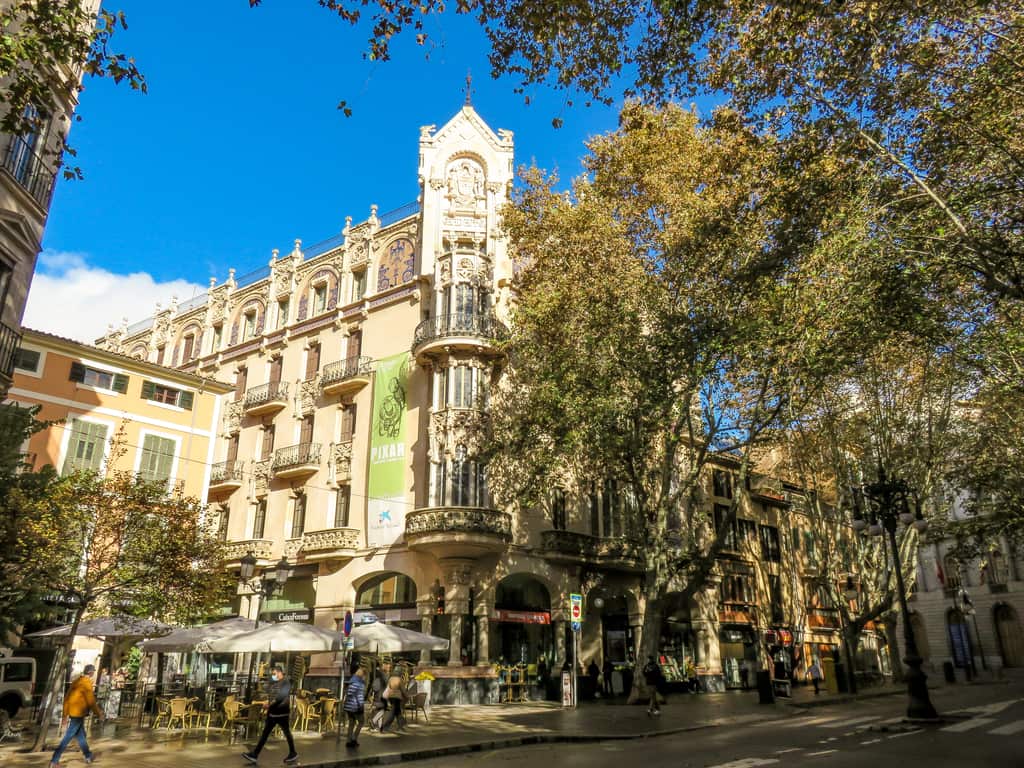
Most of the Art-Nouveau architecture in Palma is located in the city centre between Plaça Mayor and the Cathedral, and along La Rambla and Passeig des Born. Around Plaça del Mercat you’ll find the imposing Gran Hotel, the lovely Forn des Teatre and the twin-buildings of Can Casasayas. A few hundred metres further, at Plaça del Marquès del Palmer, you can admire the stunning Can Forteza Rey and the Almacenes El Águila, influenced heavily by the Vienna art-nouveau movement.
In the Santa Catalina and El Jonquet neighborhoods, there are also some beautiful examples of Modernista architecture like La Central hardware store, Can Pujol, Can Palmer, and Hostal Cuba.
Read more: All of Palma’s Art-Nouveau buildings at one place which short history and a handy map to find them

12. Visit the Royal Palace of La Almudaina
La Almudaina is proudly standing next to La Seu, and together with the Cathedral is one of the most famous landmarks in Palma de Mallorca. This fortified palace was built in the 14th century for James II at the place of an Arab fortress. The palace is one of the official summer residences of the Spanish King. When the King’s not there, the palace is open for visits. Unfortunately, I wasn’t able to visit the palace, as I was short on time in Palma.
Practical info:
Address: Palau Reial s/n (In front of the Cathedral)
Admission fee: 7 EUR; free entrance Wednesday and Sunday from 3 pm to 6 pm;
Opening times: Tuesday-Sunday, from 10 am to 6 pm:
Buy your ticket here
13. Take a journey in time at Can Balaguer
Can Balaguer is for sure one of Palma’s hidden gems. I was lured in by the beautiful courtyard only to discover that the whole house was a museum and could be visited free of charge. It houses the permanent exhibition A Possible Home: domestic interiors in Palma (1600-1951). The last owner of the house, Josep Balaguer (Inca, 1869 – Palma, 1951), was a musician and one of the important figures on Palma’s cultural scene at the beginning of the 20th century.

Today, we can wander from one room to other, passing through time and admiring the period furnishings: Baroque, Rococo, Louis XV…
Besides musician, Balaguer was also a collector, and today we can see his collection, which includes works of the famous Mallorcan impressionist Antoni Gelabert (1877 – 1932), alongside with paintings from the municipal collection of the modernists Santiago Rusiñol, William Degouve de Nuncques, Hermenegild Anglada Camarasa, Francisco Bernareggi and Roberto Montenegro.
Practical info: Can Balaguer
Address: Calle de la Unió 3, 07001 Palma
Admission fee: free of charge
Opening times: Tuesday-Friday, from 10 am to 5 pm; Saturday-Sunday, from 11 am to 2 pm
14. Marvel the beautiful La Llotja
La Llotja is one of the most beautiful examples of Gothic architecture not only in Palma, but on the whole island. With its turrets and arches, it looks as if it comes straight from a fairy tale. La Llotja (or La Lonja in Spanish) is the former stock exchange building of Palma. In the 15th century Mallorca was a major maritime trading centre and it deserved an imposing meeting point for its merchants.

The well-known Mallorcan architect and sculptor Guillem Sagrera was entrusted with the design of the building, which resulted in a pure architectural gem. The construction of La Llotja was finished in 1452.
As commerce declined, La Llotja was turned into a storehouse for goods and munitions, to finally become a gallery for fine art at the end of the 19th century. Today, you can visit La Llotja only when there are exhibitions. The square where La Llotja is located is absolutely lovely and there are a few cafes and restaurants where you can grab a bite or some refreshments.
Practical info:
Address: Square de la Llotja, 5, 07012 Palma
Admission fee: free of charge
Opening times: only when there exhibitions
15. Visit the round castle Bellver
Castell de Bellver is one of the few round castles in Europe. It was built in the 14th century for King James II of Majorca and served as a residence of the Kings of Majorca until the 17th century. Afterwards it was a military prison and in 1932 it became a museum. Today, the Museum of History of the City of Palma is housed in the castle.
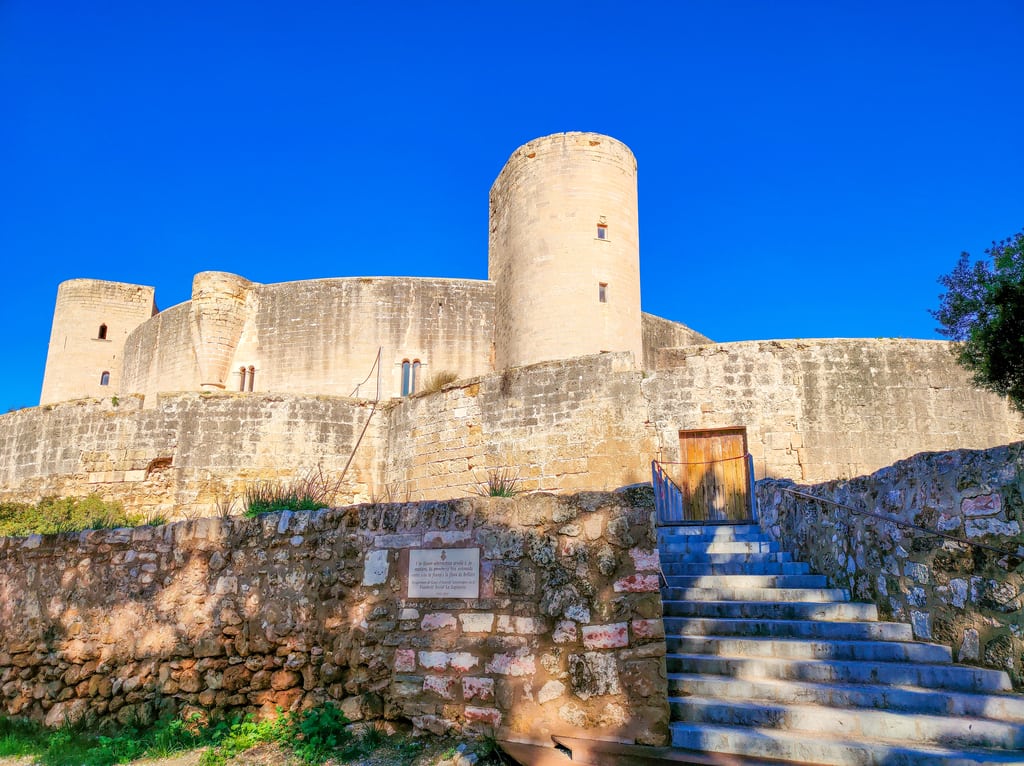
Bellver stands proudly on a hill, just outside of the city’s centre. You can go there by bus, but be prepared for some hiking, as you will need to climb the small hill. However you will rewarded by some amazing views of Palma and the Mediterranean! On the way to the castles, you’ll pass by the lovely Capella de Sant Alonso Rodríguez, built in 1865.
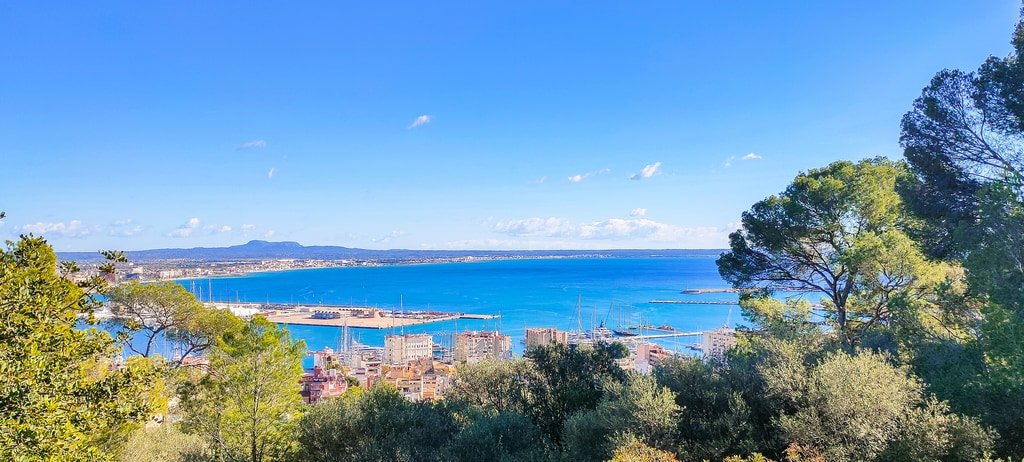
When I wanted to visit the castle it was a really bad timing, as I had planned it for Monday morning, but it turned out that it was closed on Monday. Well, this didn’t stopped me to still go to the castle and have a look from the outside. It’s still worth the visit, even if you don’t go inside. The views from the castle are also quite beautiful!
Practical info: Castell de Bellver
Address: Carrer de Camilo José Cela, s/n, 07014 Palma (bus lines 1, 4, 20 + some walking)
Admission fee: adults: 4 EUR, children (14-18 years): 2 EUR; free admission on Sundays
Opening times: Mondays – closed; April-September: Tuesday-Saturday, from 10 am to 7 pm; Sunday, from 10 am to 3 pm; October-March: Tuesday-Saturday, from 10 am to 6 pm; Sunday, from 10 am to 3 pm
16. Learn about Mallorca at the local museum
The Museum of Mallorca (Museu de Mallorca) is hidden in the Medieval Town. It’s housed in a former residence of the Counts of Ayamans, which is known by the name Ca la Gran Cristiana, referring to Catalina Zaforteza y de Togores, a famous Mallorcan carlist. The residence was built around 1630, using the foundations of an Arab house.

The museum opened in 1968 and its collection comprises of several thousand exhibits from prehistoric artefacts to Moorish ceramics and jewelry, from medieval and Baroque paintings to 19th and 20th century art. So, if you want to learn everything about the history of Mallorca, you should visit this museum.
Practical info: Museu de Mallorca
Address: Carrer de la Portella 5, 07001 Palma
Admission fee: free of charge
Opening times: Monday- Friday, from 10 am to 6 pm; Saturdays, from 11 am to 2 pm; closed on Sundays
17. Relax at one of Palma’s beautiful gardens
You can find them scattered all around the city – the beautiful gardens of Mallorca. Some of them are quite obvious, like small parks, other are hidden behind high walls. They all share one common feature – they are truly beautiful, a real green oases amid the medieval city!


When I visited Palma, I wasn’t searching for them but I took the opportunity to visit all gardens if I stumbled upon them. Here I’ve listed some of them:
- El Jardí del Bisbe (the Bischop’s Garden) – Carrer de Sant Pere Nolasc 6;
- S’Hort del Rei (the King’s Garden) – Avinguda d’Antoni Maura 18;
- Parc de la Mar (the Seaside Park) – at the foot of the city walls and the Cathedral
- the walled garden of Banys Àrabs – Carrer de Can Serra 7
- Parc de Sa Feixina – Avinguda de l’Argentina, s/n
- Jardins de Marivent – Avinguda de Joan Miró 229
- Jardines de la Misericordia (the Gardens of Mercy) – Via Roma 2
18. Stand in awe of the old olive tree
One of Palma’s symbols is the old olive tree (Olivera de Cort) on Plaça de Cort, in front of the Town Hall. This 600-year-old tree was transported to Palma from Pollença in 1989 and planted there as a symbol of peace. Since then it has also become one of the symbols of the Palma.

19. Admire the undersea world at Palma Aquarium
If you are visiting Palma with kids, they will love the Palma Aquarium. The aquarium is also one of the best attractions in Palma. You can see there the underwater inhabitants of the Mediterranean and admire the tropical coral reefs. You can visit the AquaDome and see sharks through the glass floor of a boat.
Check the availability before you book tickets:
Practical info: Palma Aquarium
Address: C/ Manuela de los Herreros i Sorà 21, 07610 Palma de Mallorca (bus lines 23 and 35)
Admission fee: start from 42 EUR
Opening times: closed until March 2022
Buy tickets here
